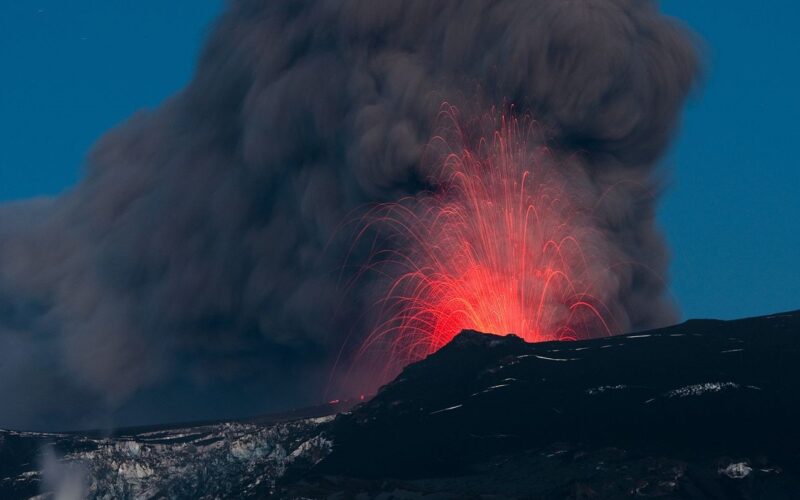Recently, Iceland has been experiencing increased seismic activity, with hundreds of small earthquakes affecting the Reykjanes Peninsula region, located close to the Icelandic capital and Keflavik International Airport (KEF).
This increased seismic activity has been caused by the Fagradalsfjall volcano, which has been exhibiting signs of instability, prompting Iceland’s Met Office to declare an eruption to be almost certain.
On November 11, 2023, the Icelandic authorities declared a state of emergency in response to the situation.
Approximately 4,000 people were evacuated from a town near the volcano as a precaution. Iceland’s aviation alert has also been raised to orange, indicating an increased risk of a volcanic eruption.
Despite the proximity to the potential eruption site, Keflavik International Airport currently remains operational, with flights arriving and departing as scheduled.
The Eyjafjallajokull eruption of 2010: a catastrophe for global air travel
This situation may stir memories of the major eruption on April 14, 2010, when an eruption of the Eyjafjallajokull volcano severely disrupted all air travel, sending a black ash plume that reached 9 kilometers into the atmosphere.
Over a six-day period, more than 100,000 flights were canceled, affecting approximately 10 million passengers globally.
As a result, the airline industry suffered significant financial losses, estimated to be around $1.7 billion. The broader economic impact was also significant, causing disruption to tourism, freight transportation and international trade.
The event prompted a global reassessment of preparedness strategies for natural disasters.
Aviation industry revamps safety protocols
In response to the 2010 Eyjafjallajokull eruption, the aviation industry, together with international regulatory bodies, instituted a range of new guidelines and protocols to enhance safety and efficiency in dealing with volcanic events.
- The use of more advanced satellite systems, such as the Volcanic Ash Advisory Centers (VAACs), was intensified. For example, the London VAAC, one of nine global centers, expanded its use of satellite data and computer modeling to provide more accurate and timely information about ash cloud movements.
- The International Civil Aviation Organization (ICAO) introduced a new approach to airspace management following the eruption. Instead of widespread airspace closures, a concept of ‘ash concentration thresholds’ was developed. This allowed for the categorization of airspace based on varying levels of ash density, enabling some flights to continue in lower-risk areas.
- Aircraft and engine manufacturers such as Boeing and Rolls-Royce conducted extensive research to understand the effects of ash on engines. Based on these studies, they revised their operational guidelines, establishing new thresholds for ash ingestion that are considered safe for jet engines.
- Certain airlines and airports developed more robust contingency plans, amongst them British Airways, Heathrow (LHR), Lufthansa, Frankfurt Airport (FRA), Air France, Charles de Gaulle Airport (CDG), KLM, Amsterdam Schiphol Airport (AMS), Delta Air Lines, Hartsfield–Jackson Atlanta International Airport (ATL), Singapore Airlines and Changi Airport (SIN). These plans included strategies for rerouting flights, accommodating stranded passengers and managing extensive delays or cancellations.
- Airlines updated their training programs to prepare pilots for flying in volcanic conditions. Simulators were programmed with scenarios that can replicate the experience of flying through ash clouds, providing pilots with practical experience in handling such situations.
Contrasting volcanic hazards for air travel
Overall, as a result of the 2010 eruption, the improved preparedness and response capabilities of the aviation industry have made air travel safer in the face of volcanic activity. These precautions not only protect aircraft and passengers but also reduce the economic and logistical effects of volcanic eruptions on global air travel.
Eyjafjallajokull, a stratovolcano, is known for explosive eruptions. Its ice cap covers an area of about 100 square kilometers (39 square miles), and the interaction of hot magma with glacial ice adds to its explosivity yet further.
In contrast, Fagradalsfjall is part of a system of shield volcanoes, typically associated with less explosive, effusive eruptions that produce lava flows rather than extensive ash clouds.
While Eyjafjallajokull’s eruption poses a broader danger due to potential ash dispersion affecting air travel, Fagradalsfjall’s impact might be more localized. Nevertheless, it could still be significant, particularly if lava flows affect nearby communities or critical infrastructure such as Keflavik International Airport, located approximately 25 kilometers (about 15.5 miles) from the Fagradalsfjall.
As such, though Fagradalsfjall’s eruption could impact local areas and air travel in Iceland, it is unlikely to have extensive global implications on the same scale as the 2010 Eyjafjallajokull eruption.

